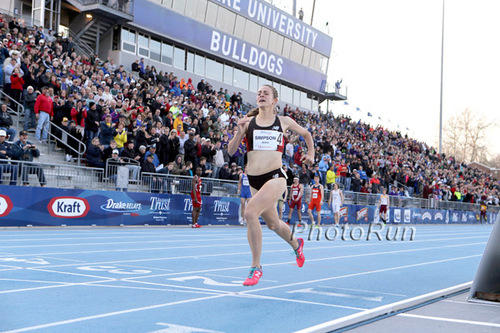
Jenny Simpson at the 2013 Drake Relays, photo by PhotoRun.net
2014 DRAKE RELAYS Thursday, by James Dunaway
Des Moines, April 24, 2014 — As the 105-year-old Drake Relays gets going today, we’re a little more than two years from the 2016 Olympic Games in Rio de Janeiro. This might be a good time to step back a bit and take a long-range look at track and field in terms of its history, and perhaps its future.
IF it has one.
Track and field as an organized sport is only about 150 years old. It began in the United States during the great sports explosion which took place after the Civil War and included boxing, horse racing, organized baseball, collegiate sports and later golf and tennis, among others.
Some of these sports flourished mightily in the first half of the Twentieth Century. In what was called “the Golden Age of Sport,” giants like Babe Ruth, Dizzy Dean, Jack Dempsey and Bill Tilden, commanded enormous media attention and newspaper headlines.
When Ruth signed for $80,000, a sports writer said, “Babe, you’re making more than the President,” and the Bambino responded , “Well, I had a better year than he did.”
In those days, everybody knew the name of the World Heavyweight Champion, and every boy knew the current batting average of every player on his favorite big league team. But the average sports fan also knew who Jesse Owens was, and the “Flying Finn,” Paavo Nurmi, who used to fill New York’s Madison Square Garden to overflowing when he attacked world indoor records.
Today, though, the last worldshaking track-and-field headline was Roger Bannister’s 3:59.4 mile, run in 1954. Even the stunning sprint times posted by Jamaica’s Usain Bolt at the World Championships and Olympics rate no more than a flashy note about a passing phenomenon.
What’s going on, anyway?
One might draw a parallel with the newspaper business. For most of the Twentieth Century, almost every American read a newspaper (or two) almost every day. Newspapers had the time to run long, detailed track-meet stories written by reporters who knew the sport they were covering as well as the athletes.
Television brought a huge change to track coverage. Sports editors assumed that if an event were covered on TV, the people who were interested in it had seen it on their TV sets. So the reporters spent their time getting quotes from the athletes, and as newspapers’ circulation dwindled, so did the length of their track stories.
However, track and field are difficult for TV to cover. Unlike football, basketball, and even golf and tennis, most sports offer some way to provide some sort of non-stop picture material for their cameras. And it’s virtually impossible to reproduce on television the mounting excitement of a close throws or jumps competition between two or three world-class athletes.
(more tomorrow)
(Editor’s note: James Dunaway will be covering Drake for RunBlogRun. Dunaway is the long time editor of American Track & Field magazine, and a contributor to Track & Field News for the past six decades).
Larry Eder has had a 52-year involvement in the sport of athletics. Larry has experienced the sport as an athlete, coach, magazine publisher, and now, journalist and blogger. His first article, on Don Bowden, America's first sub-4 minute miler, was published in RW in 1983. Larry has published several magazines on athletics, from American Athletics to the U.S. version of Spikes magazine. He currently manages the content and marketing development of the RunningNetwork, The Shoe Addicts, and RunBlogRun. Of RunBlogRun, his daily pilgrimage with the sport, Larry says: "I have to admit, I love traveling to far away meets, writing about the sport I love, and the athletes I respect, for my readers at runblogrun.com, the most of anything I have ever done, except, maybe running itself." Also does some updates for BBC Sports at key events, which he truly enjoys. Theme song: Greg Allman, " I'm no Angel."
View all posts



















